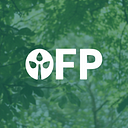OFP at COP26: A Synopsis

The 26th convention of the parties, COP26, was the most important climate summit since Paris. Of the many goals of the summit, the most important was the initiative to keep global surface temperature warming below 1.5 degrees celsius, or “keeping 1.5 alive.” Many commentators see the failure to fully phase out coal and the lackluster commitments of capital to developing nations as indicators that we are now condemned to a future beyond 1.5 degrees of warming.
The perceived failures are a result of discussions taking place in the “blue zone,” the area of the conference where world leaders meet to craft international policy. While world leaders were busy in the blue zone, the OFP team was finding more success in the green zone, where the world’s most influential NGOs and companies get together to talk about non-governmental climate solutions.
CEO Frederic Fournier and Business Developer Rado Dragov represented the Open Forest Protocol as members of the CIFOR delegation to COP26. At the conference, they met with scientists, activists, entrepreneurs, and government officials to share ideas about nature-based climate solutions and blockchain. Here are their main takeaways:
Nature-based solutions — so hot right now
Nature-based solutions (NbS) are favored by countries that see environmental restoration as a multi-tier benefit to their countries. In general, NbS improve water quality, regulate temperature, improve access to resources for local communities, and provide wildlife habitat. A recent study from the Nature Conservancy suggests that as much as 37% of necessary emission reductions necessary before 2030 can come from NbS in the form of reforestation, peatland restoration, blue carbon, and more. When countries look at their options for meeting net zero emissions, NbS and their associated benefits represent the best way forward.
Countries whose economies are heavily dependent on fossil fuel exports are particularly keen on leveraging nature to offset their emissions. Rado met with representatives from Saudi Arabia, a nation seeking to combat desertification with tree planting. Despite its desert climate, the Kingdom of Saudi Arabia plans to plant 10 billion trees in the coming decades increasing its forested area twelvefold (from 0.5% to around 6%). Temperatures in Saudi Arabia are projected to rise faster than the global average and the Kingdom is taking action to mitigate the adverse effects.
Expectations vs Reality
The OFP team was hoping to meet with forest projects and entrepreneurs to discuss localized collaboration. We wanted to get a pulse for where the entire movement is heading in terms of NbS and the voluntary carbon market. When government officials began asking about the possibility of incorporating OFP into their national carbon registries, we realized we had exceeded our expectations.
Our team met with government representatives from the Democratic Republic of the Congo, Kenya, Panama, Nigeria, Ghana, Bangladesh, Pakistan and Indonesia. The following is a quick run-down on our most promising leads from the conference.
Democratic Republic of the Congo
The DRC plays an integral role in the global forestation effort. Roughly seven times the size of Germany, the DRC is home to some of the world’s most biodiverse tropical rainforests. In fact, the Congo Forest is the second largest intact block of tropical rainforest in the world. We spoke with Gervais Rugenge Baguma (Chairman of the Board of Directors for the DRC National Forest Fund) and Albert Boliko Lomoto (Deputy Director of International Cooperation and Planning Unit), both of whom expressed interest in adopting our solution at the national level. They were particularly interested in OFP’s capacity to provide a reliable and accessible source of funding for their ambitious tree planting efforts. We will be continuing this conversation into the new year, and looking to establish a foothold in the DRC at the national level by Q2 of 2022.
Kenya
Kenya has a goal of increasing their forest cover from 7.2% to 10% by 2022. This effort will require the propagation of over 2 billion seedlings. When we spoke with representatives from Kenya National Forest Service, they told us that their biggest barrier to success is funding. They have the potential to unlock massive stores of carbon through a country-wide reforestation effort, and they just need to be able to communicate that potential to investors. In other words, they outlined a problem that OFP is in an ideal position to solve. Using our platform, the Kenyan government will be able to measure the success of their individual operations, improving trust with stakeholders and propelling them into the forefront of the global carbon economy.
Panama
Fred and Rado also met with Victor Francisco Cadavid, Panama’s Director of Forests. After sharing an in-depth introduction to the protocol, Victor shared what he learned with the Panama Minstry of Environment. We have a follow-up call with the Ministry next week to identify a pilot project and establish a presence in central America.
All Hands on Deck
A persistent myth in the climate discourse, and one that commentators of events like COP26 sometimes lean into, is that climate change is a problem we can avoid altogether. Despite what arbitrary (but useful) distinctions between degrees of warming might insinuate, there is no objectively identifiable point-of-no-return.
Climate change is not an event to be avoided; it is a timeline to be managed. We need all hands on deck to manage the crisis. We can’t rely on the government alone to solve the problem. If we are to avoid the worst of this crisis, we need robust and innovative nature-based solutions, we need technological solutions that incentivize restoration, and we need transparency along the way. As countries around the world begin to take notice in OFP, we are more confident than ever that our solution rises to this challenge.
